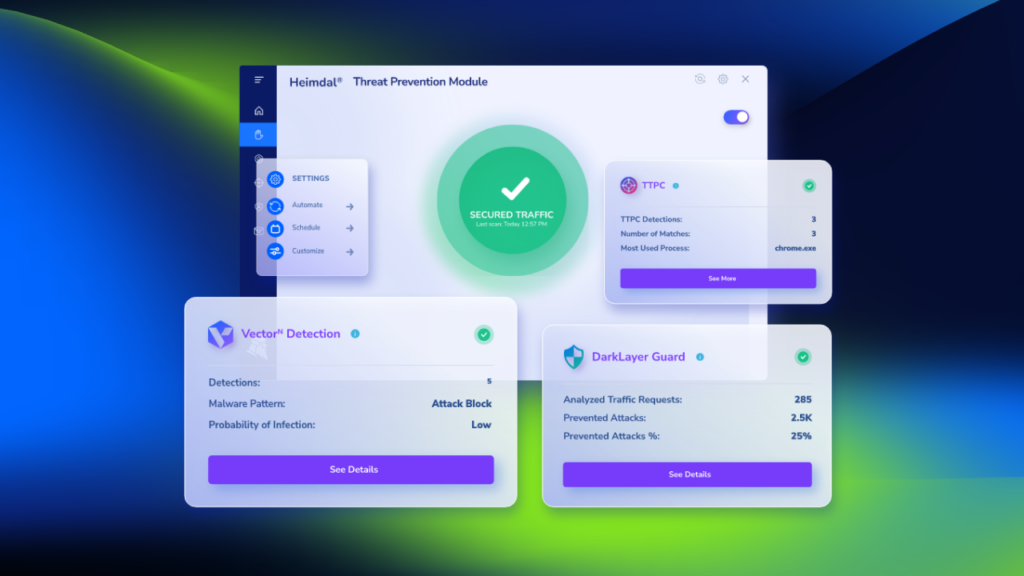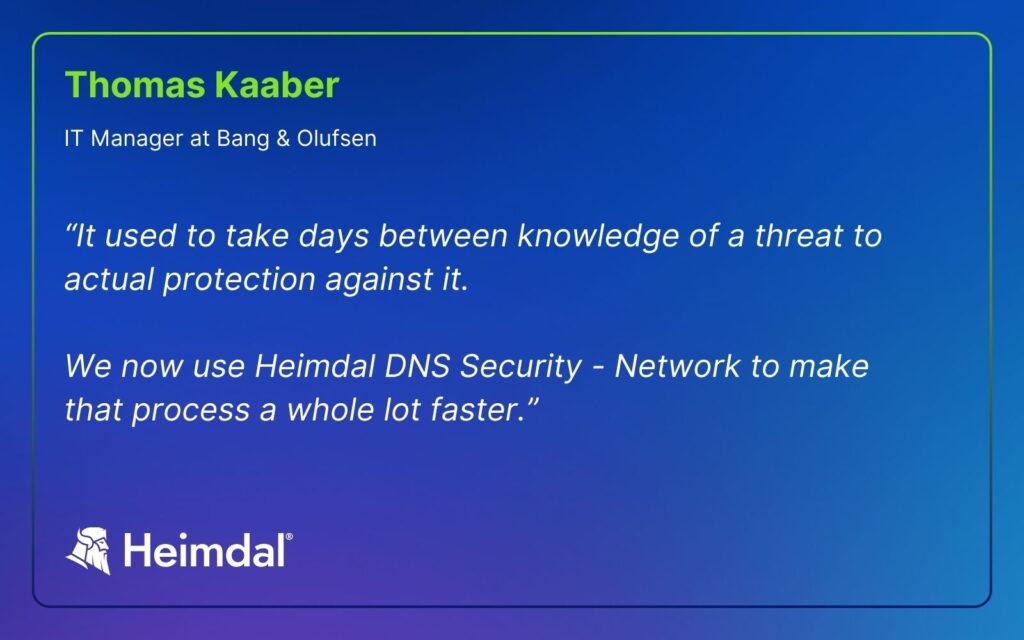Contents:
DNS scavenging is the process of removing stale DNS records. It helps keep the DNS server’s database clean and efficient. Most of the time, IT Administrators use it along with DNS aging to free up space and improve system performance.
This Windows Server feature is also a defensive measure. By routinely clearing outdated records, you lower the risk of DNS-related vulnerabilities, such as cache poisoning. While Linux doesn’t have a built-in feature for DNS scavenging, you can get there using DNS server software and custom scripts.
This article will explore how DNS scavenging works, how to enable it, and why it plays an important role in maintaining DNS security.
Key takeaways:
- DNS scavenging reduces the risk of a DNS caching attack
- Removing stale DNS records is one of the DNS best practices
- Misconfiguring scavenging and deleting active records causes network disruption
- You can improve your DNS security by using Heimdal’s DNS Security solution
How does DNS scavenging work?
DNS scavenging works by identifying and removing stale or outdated DNS records from a server.
Each DNS record has a timestamp indicating its last updating time. Timestamps are set up automatically when creating or updating a record via dynamic DNS (DDNS). Static records are created manually and have a timestamp of 0. You can’t automatize scavenging unless you reconfigure them.
To enable scavenging on a Windows server, configure it on:
- individual DNS records
- the DNS zone
- the DNS server
Set up scavenging options in the DNS Management Console (MMC) and set appropriate scavenging intervals.
The process relies on two key intervals:
- the No-refresh interval. It prevents DNS record timestamp updates to reduce unnecessary replication traffic.
- the Refresh interval. This follows the No-refresh interval and allows the client to update the DNS record’s timestamp.
After both intervals pass, the record becomes eligible for scavenging. During a scavenging cycle, the DNS server checks each record’s timestamp against the current time. If the current time exceeds the record’s timestamp plus the No-refresh and Refresh intervals, the record is stale.
Before deleting a stale record, the scavenging process ensures that the zone’s replication is up to date. It must also ensure that the record is stale across all DNS servers hosting the zone. If all conditions are met, it removes the stale record from the DNS database.
DNS scavenging vs DNS aging
As I mentioned above, DNS scavenging and DNS aging are usually used together to identify old DNS records.
DNS aging identifies the ‘stale DNS record’ from the DNS server by keeping track of its ‘age’, and to be more precise – its time stamps. The age of the DNS record is the difference between the last time stamp and the current time of the server.
DNS scavenging uses this value to check if the record needs to be removed and, after identifying the eligible stale resource records, proceeds in removing them from the DNS server.
What are the benefits of DNS scavenging?
Stale DNS records can lead to problems within the DNS resolution. The problem with stale records is threefold, as they:
- generate duplicate records
- waste storage space
- reduce DNS server performance
The main benefits of scavenging stale records are:
Preventing DNS cache poisoning
One of the biggest benefits of DNS scavenging is that it can help prevent DNS attacks, like cache poisoning. DNS cache poisoning is a version of DNS spoofing.
DNS caching refers to storing previously resolved domain names locally for a certain amount of period. In the DNS resolution process, caching reduces lookup times and decreases the load on DNS servers. The bad news is hackers can exploit it to redirect users to malicious sites.
To achieve that, they need to compromise DNS records and insert false address records into a DNS cache. A regular DNS scavenging process removes old, potentially compromised records, thus preventing a potential threat to evolve into a DNS attack.
Heimdal can help achieve better DNS protection across your infrastructure. Get a free demo for DNS Security – Network to understand how our solution can keep you safe from DNS attacks like DNS caching.
Avoid overloading servers
DNS scavenging can help protect against distributed denial of service (DDoS) attacks. In a DDoS attack, cybercriminals attempt to overload a server with requests in order to cause it to crash.
By scavenging DNS records, organizations can reduce the number of requests that their servers need to handle. Thus, the servers are less likely to get overloaded and more able to withstand an attack.
Improve internet availability
DNS scavenging can help improve internet speed. Removing old records from the DNS system reduces the amount of data that needs to be transferred between servers. This can reduce latency and improve overall internet speed.
Enabling DNS scavenging
You can enable DNS scavenging either manually or automatically. Manual scavenging involves manually checking for and removing old DNS records. This can become a resource consuming, burdening task for IT teams. Automatic scavenging uses software to automatically find and remove old DNS records.
DNS scavenging works on a per-server or per-zone basis. Here’s the difference:
- zone scavenging affects a single zone
- server scavenging affects an entire server
To learn more about what how this feature works on a Windows Server and how to enable it, follow the steps in this article from Microsoft Community.
Potential drawbacks of DNS scavenging
DNS scavenging can cause problems if you misconfigure it. That is why you should first try it on a test machine and prepare a rollback plan.
Here’s what can go wrong and why.
Accidentally deleting active records
Misconfigured scavenging can lead to deleting records that are still in use. Usually, deleting active records can happen if:
- a device is turned off for a period of time
- a network issue prevents the device from contacting the DNS server
When the device is turned back on or the network issue is fixed, the device will try to contact the DNS server to update its record. They won’t find the record anymore and this will cause errors and disruptions for users trying to access services.
Replication issues
If DNS servers are not properly replicating records, valid records might be prematurely marked as stale and deleted. This will make the network unstable.
Impact on Dynamic DNS (DDNS)
When a device uses DDNS, it periodically sends updates to the DNS server to refresh its DNS record. Thus, it makes sure that the server always has the latest information.
If these updates are not processed correctly, the DNS server might not receive the latest information and mistakenly classify these records as stale. Then the next scavenging process will remove records it believes are stale, including the incorrectly processed dynamic records. This will disrupt network services for the devices in cause.
Service disruptions
Deleting essential DNS records can lead to failures in locating critical network resources, such as domain controllers, email servers, and other network services.
Data integrity risks
Inaccurate scavenging settings might lead to a loss of important DNS information, complicating troubleshooting efforts and the restoration of services.
To avoid problems from the start, it’s important to ensure that all devices are configured to update their DNS records regularly. This way you won’t risk your records being removed prematurely.
How can Heimdal® help?
While DNS scavenging and aging help you maintain a clean DNS cache, they don’t work as stand-alone security measures. Enabling DNS scavenging and aging is part of a comprehensive DNS strategy.
Take your DNS protection to the next level, with Heimdal’s DNS Security tool, part of Heimdal’s cybersecurity platform.

This DNS security solution integrates a unique feature. Heimdal’s Predictive DNS scans user traffic on the go using artificial intelligence and machine learning. The tool helps you predict and stop DNS threats with 96% precision, so you can secure both your endpoints and your network.
Whether on-site or remotely, Heimdal® DNS security scans your users’ traffic in real-time, blocking infected domains and preventing communication with cybercriminal infrastructures. This gives administrators complete confidence while securing internet browsing for all users.
Heimdal® DNS Security Solution
Wrapping up
DNS scavenging is an excellent practice for DNS maintenance, so it’s definitely worth giving it a try. DNS aging and scavenging maintain a cleaner and more secure DNS cache, less susceptible to poisoning attacks, as well as a smoother browsing experience.
If you want to improve your cybersecurity posture, you can always rely on Heimdal to assist you. Book a demo with us today and experience it firsthand.
If you liked this article, follow us on LinkedIn, Twitter, Facebook, Youtube, and Instagram for more cybersecurity news and topics.










 Network Security
Network Security
 Vulnerability Management
Vulnerability Management
 Privileged Access Management
Privileged Access Management  Endpoint Security
Endpoint Security
 Threat Hunting
Threat Hunting
 Unified Endpoint Management
Unified Endpoint Management
 Email & Collaboration Security
Email & Collaboration Security











